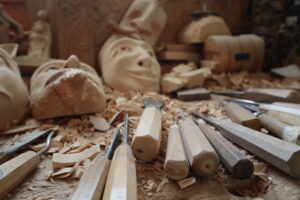ITALIAN MASKS: BETWEEN GAMES, HISTORY, AND CULTURE — Part 1
Thinking of masks and disguises in Italian culture, one of the first examples that probably comes to mind is the Venetian Carnival, with its sophisticated image and refined and exclusive style.
HIDING IN THE SEARCH FOR FREEDOM

Certainly, this is among the most famous Carnivals in the world and one with a long historical tradition that goes back to the XIth century. However, not everyone may know that this carnival used to run for at least six weeks from December, and sometimes from October. Aside from the baroque splendor of its clothes and accessories, since its origins it has also been associated with the search for freedom: in particular, the liberation from social norms. In fact, the costumes, particularly the traditional masks, can “transform” someone into an unrecognizable individual.

The larva—the traditional white mask—covers the face completely but leaves space in front of the mouth for eating and drinking without the need to remove it, allowing a complete annihilation of the identity. This frees the person behind the mask to take a break from the expectations and the restrictions that one’s social status might impose upon them. It is a way to escape from strict behavioral expectations or to liberate oneself from the weight of past bad actions or malicious gossip. Free to act beyond the limitations of time and space.

*
WOODEN MASKS IN THE ALPS
Although the Venetian Carnival is the most sumptuous of them all, the carnival is a cultural celebration that doesn’t go unnoticed in the other twenty Italian regions, although with different degrees of sparkle.


In the Alps region, for example, the most famous is the Sauris Carnival, named after the town where it takes place. Sauris, located at an altitude of 4,600 feet above sea level, is a picturesque alpine village in the Friuli-Venezia Giulia, in the north-eastern corner of the country, neighboring the Venice region to the West, Slovenia to the East and Austria to the North. It has a population of 400 people and was awarded UNWTO Best Tourism Village in 2022.

Sauris is an example of what in Italy is called “albergo diffuso”. This concept identifies that a community-based plan has been drawn up with valorization of/giving value to the local culture through responsible tourism practices at its centre, and which has a capillary network of accommodation “spread” (diffuso in Italian) across several locations in the village.

There are two main characters in this carnival: Rölar and Kheirar.
Rölar wears dark clothes, his face is covered with soot, and he is particularly noisy due to the number of röln (bells, from which his name derives) he wears around his waist. This sound informs everyone that it is time to put their masks on.
Kheirar wears a wooden mask and ripped clothes, and uses the broom in his hand to sweep away “bad things”. He is considered the King of the Carnival.


They are followed by a big parade with the “beautiful masks” (scheana scheambln) on one side and the “ugly masks” (schentena scheambln) on the other, everyone dancing, interacting and following entertaining screenplays, which are based on traditional tales and local stories.
Storywalking would love to accompany you to attend the large bonfire and take part in the night walks by the light of traditional lanterns carried by those in wooden masks, which contributes to creating an even more surreal atmosphere, suspended in time.

*
A REAL GAME FOR A ROMANTIC TALE
Masks are worn for a different reason in Marostica, in the Veneto region. On this occasion, the masks are worn by the pieces of a living chess game that takes place on a massive chess board that is embedded permanently in the surface of the main town square. Every September in even-numbered years, this large-scale table game is watched by 3,600 people seated all around the square on a structure mounted for the occasion, and this year it celebrated the first century of its history.

But this is not a simple chess game; there is also drama and love involved. The two chess players represent two noblemen, Rinaldo d’Angarano and Vieri da Vallonara, and they compete to win the hand of the beautiful daughter of the Lord of Marostica. Each of the moves they play on the chess board on the table at the side is reproduced on the huge chess board by the actors who embody the different pieces. They are all there, including well-behaved horses.

Before and after the game, the board turns into a proper stage and other actors in historical costumes appear to tell the tale. Fire is the protagonist of a visually impactful opening, after which action, passion, and intense interaction will lead the plot to the decisive moment of the game played at the table by the two suitors.

The spectators follow the live game with great interest and curiosity, because, if the plot is known and history is repeating, the game is real and the winner is not known in advance.

Will Rinaldo or Vieri be the acclaimed winner of the next epic game?
Fireworks will crown the winner and the end of another passionate match.
Words by Elisa Spampinato
Sauris – Photo credits @ Sauris Zahre Municipal Photographic Archive
Marostica- Photo credits @ Partita a Scacchi Marostica Facebook page


